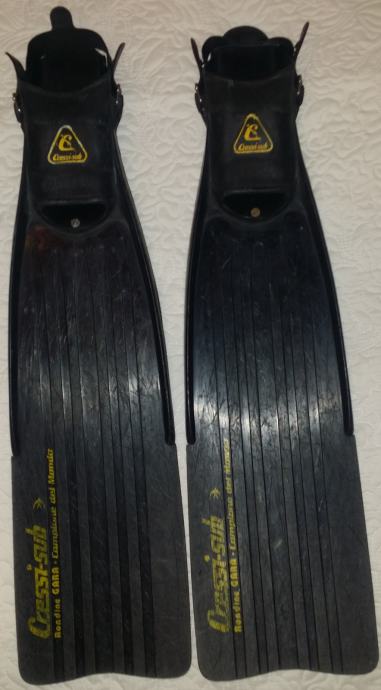I'm fascinated by fin design (and marketing lies). Always wondered how well the jet fin vent features ACTUALLY work, especially compared to a simple paddle. Not to mention all the other gimmicks on the market. Please, can you explain in more detail what changes were made and what decreased performance? The Beuchat fin looks very similar.
Regarding the effectiveness of the jet channels, they were designed for the typical kicking style in use in the sixties, and it was vey effective for people using that obsolete kicking style.
In practice, at the time, most divers employed what we called the "forward kick", flexing the knees, bringing the lower part of the leg quite backwards, leaving the fin to not push water during this backwards movement, and then pushing hard forward. So just half of the movement was active, the forward kick, whilst the backward kick was ineffective.
The jet channels operate efficiently during the forward kick, providing a large surface acting over the water and keeping the flow aligned in the most effective direction for producing forward thrust.
You can see that crap kicking style in old videos of the sixties.
Later, at the end of the seventies, people coming from finned swimming (like me) entered the free diving arena, introducing long flexible fins and a new style of flutter kicking, the "double push" style, were both the forward and backwards parts of the kicking action are equally important. This pushed the development of a new generation of fins for free divers, such as the Rondine L, the Rondine Gara, and the Mares Concorde "Scarpati".
Here the Rondine L, the first long fins used by divers:
These fins were far more efficient than the Jetfin, but required a special training for learning the proper double-action kicking style, where the knees do not flex and the action starts from hips.
So a new job appeared, the finned swimming instructor. Both I and my wife did follow the training course and became finned swimming instructors in 1980.
Later one, in the nineties, so called technical divers who needed to access narrow spaces with the risk of raising silt from the bottom (caves, wrecks) developed a new kicking style, not tailored to efficiency, but to the need of manoeuvring inside such small spaces without pushing water towards the bottom. This means mostly frog kicking, or using a modified frog kick, helicopter turns, backwards kicking, etc...
For this kind of manoeuvrings, optimal fins revealed to be short and rigid. So the Scubapro Jetfin, quite inefficient for a proper modern double-action flutter kicking, went back in fashion, being optimal for this type of "technical" kicking styles, but still allowing for a decent propulsion when flutter kicking against a current.
So they were preferred to flat paddles, as the double surface provided by the jet channels make them equivalent to longer flat fins when flutter kicking "the old style", using mostly the forward kick.
It must be said that nowadays most scuba divers do not follow anymore finned kicking courses, and they cannot use optimally the long freediving fins, as they never learned how to use the modern double-action kicking style which provides maximum speed and efficiency.
In particular, technical divers are used to keep their knees flexed. So, even when they are forced to use a more powerful and efficient flutter kicking, abandoning their beloved frog kicking as they need speed and power for swimming against current, they tend to use the old forward-kicking style, for which the Jetfin was originally designed.
This explains the success of the Jetfin for tech diving: good for frog kicking due to the very rigid rubber, foot pockets designed for boots, and still some decent power when flutter kicking against current using the old-style forward-kicking.
Of course, people as me, who were trained to proper double-action flutter kicking for free diving and finned-swimming competitions, and to always keep the knees unflexed, do not like the Jetfins.
When using boots we prefer more efficient fins, such as the Mares Power Plana 4. Or the best fins ever developed for efficient flutter kicking when wearing boots, the Cressi Rondine Gara Pro which you see here (and which are the fins I am currently using):





